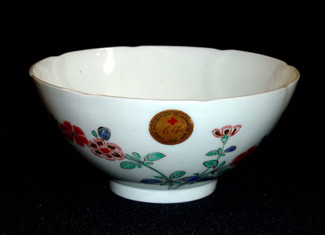 A small porcelain bowl was given in December 2007 to Scripps College by Anthony Elias and Patricia Lords Ghosn and the Worldbridge Foundation. Although modest in size, it reveals much about Japanese history, Oriental ceramics, and modern collecting.
A small porcelain bowl was given in December 2007 to Scripps College by Anthony Elias and Patricia Lords Ghosn and the Worldbridge Foundation. Although modest in size, it reveals much about Japanese history, Oriental ceramics, and modern collecting.
Several paper labels are glued onto the bowl’s side and bottom, documenting part of the object’s long and notable history. The bowl was probably made in the 18th century at kilns located near Arita, an area on Kyushu Island in western Japan. In the 1590s, Japan had invaded Korea, capturing whole villages of potters who were then relocated to Kyushu and forced to create ceramics for Japanese military families. In the early 17th century, kaolin clay, an essential component for the production of porcelain, was discovered in the Arita area, and in the mid 1640s, Chinese techniques of enamel overglaze were introduced, resulting in the mass production of delicate but durable polychromed porcelain pieces called kakiemon. Their intricate patterns and brilliant colors were applied in imitation of highly regarded Chinese imperial porcelains of the Ming and Qing dynasties; during the 18th century, Japanese kakiemon became an international phenomenon, desired worldwide from the Ottomon Empire to the American colonies.
The Scripps bowl, approximately six inches in diameter, was initially wheel-thrown and then pressed into a mold, where it was given an overall eight-lobe shaped rim and a raised spiral impression on the interior. Its creamy white glazed surface was decorated with red, green, blue, and black enamels to depict sprigs of wild pinks and small butterflies. After several firings, gold accents were brushed onto the designs. If used in Japan, one might imagine some lightly vinegared vegetables or grilled eggplant slices with a ginger sauce placed in the bowl. However, such kakiemon became highly fashionable in Europe during the 18th century, and Dutch traders exported great quantities of Japanese porcelains to France and England, where they were prized possessions in palaces and country houses. Such a piece of export ware might have been used in Europe to serve fresh berries in cream. Inside the bowl at the bottom, a small blossom was painted to delight a diner as she finished her dessert.
How the Scripps bowl got to Europe can only be surmised, but the paper labels indicate that by the early 20th century, this kakiemon piece had entered the collection of Sir Hercules Read, who became keeper of British and medieval antiquities at the British Museum. As a young man, Read had helped catalogue the British Museum’s collection of ceramics from around the world, and he probably purchased the bowl for himself. A round label with a red cross and the text “1915 Loan Exhibition of Japanese Art” indicates that the bowl was displayed in London as part of a fund-raising effort for the Red Cross during World War I. Other labels on the bowl’s bottom reveal that the Scripps piece had been part of the “Oriental Ceramic Soc’y 1956 Exhib’n” on loan from Richard de la Mare, one of the founders of the publishing house Faber & Faber and son of the famous English poet Walter de la Mare. Faber & Faber was noted for having produced numerous scholarly volumes on Oriental ceramics, including the important study Japanese Porcelain by Soame Jenyns.
Mr. and Mrs. Ghosn, who live in Upland, Calif., acquired the kakiemon bowl at an estate sale in Switzerland, and they felt that such an historic piece with its extraordinary documentation would be appropriate for the Scripps College collections. Although the Ghosn family has no direct connection with Scripps College, they have attended many exhibitions at the Williamson Gallery and Clark Museum, where the Asian arts collections have been regularly featured. While the College has a large collection of contemporary ceramics, this is the first example of 18th century kakiemon to be received as a gift. It will undoubtedly be used in exhibitions on Japanese arts and on European culture of the 18th century.
The Worldbridge Foundation was established by the Ghosn family as a way of educating Americans about various cultural traditions through the arts, and they recently helped sponsor an exhibition at the Seattle Art Museum titled “Japan Envisions the West,” in which a similar kakiemon bowl from the Kobe Museum of Art was displayed as an example of 18th century globalization with Japanese products being sold in Europe and the Americas.
Written by Bruce Coats, Professor of Art History.

